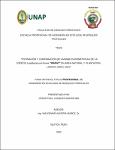| dc.contributor.advisor | Alegría Muñoz, Waldemar | |
| dc.contributor.author | Vasquez Amasifuen, Cesar Paul | |
| dc.date.accessioned | 2023-11-15T15:46:19Z | |
| dc.date.available | 2023-11-15T15:46:19Z | |
| dc.date.issued | 2022 | |
| dc.identifier.other | 684.99 V32 2022 | |
| dc.identifier.uri | https://hdl.handle.net/20.500.12737/9506 | |
| dc.description.abstract | Lepidocaryum tenue "irapay" is a non-timber forest species of high socioeconomic value. Previous research reports the biometric variables of this species in its natural habitat. However, they are unknown in plantations because they have not yet been studied. The objective of this research was to estimate and compare the biometric variables of a Lepidocaryum tenue population in its natural habitat and in plantation. The biometric variables of this species were obtained through a census of a plot within a natural stand and in a plantation in northwestern Amazonia. The research design was quantitative, cross-sectional and comparative; descriptive and inferential statistics were used; the Wilcoxon nonparametric test was used to verify the existence of significant statistical differences between the means of the biometric variables of both populations. 751 palms were recorded in the natural area, and 334 in plantation. The mean total height of both populations did not show significant differences (p > 0.05), while the mean stem height, stem diameter, number of leaves per palm, number of fruits per palm in natural area and in plantation showed significant differences (p < 0.05). The 0.39 % of palms in natural area and 13.77 % of palms in plantation had flowers. The juvenile class in both populations contributed with the highest number of palms. These findings suggest that the environment where Lepidocaryum tenue grows influences its biometric variables and highlight the need to study the physical, chemical and biological factors that trigger these differences. | en_US |
| dc.description.abstract | El Lepidocaryum tenue “irapay” es una especie forestal no maderable de alto valor socioeconómico. Previas investigaciones reportan las variables biométricas de esta especie en su estado natural. Sin embargo, se desconocen en plantaciones debido a que todavía no han sido estudiados. El objetivo de esta investigación fue estimar y comparar las variables biométricas de una población de Lepidocaryum tenue en estado natural y en plantación. Las variables biométricas de esta especie fueron obtenidas a través del censo de una parcela dentro de un rodal natural y en una plantación al noroeste de la amazonia. El diseño de investigación fue cuantitativo del tipo transversal y comparativo; se utilizó la estadística descriptiva e inferencial; se usó la prueba no paramétrica de Wilcoxon para verificar la existencia de diferencias estadísticas significativas entre las medias de las variables biométricas de ambas poblaciones. Un total de 751 palmeras fueron registradas en área natural y 334 en plantación. La altura total promedio de ambas poblaciones no mostraron diferencias significativas (p > 0.05). La altura promedio del estípite, diámetro del estípite, número de hojas por palmera, numero de frutos por palmera en área natural y en plantación mostraron diferencias significativas (p < 0.05). El 0.39 % de palmeras en área natural y el 13.77 % de palmeras en plantación tuvieron flores. La clase juvenil en ambas poblaciones contribuyeron con la mayor cantidad de individuos. Estos hallazgos sugieren que el ambiente donde se desarrolla el Lepidocaryum tenue influye en sus variables biométricas y resaltan la necesidad de estudiar los factores físicos, químicos y biológicos que originan esas diferencias. | es_PE |
| dc.format | application/pdf | es_PE |
| dc.language.iso | spa | es_PE |
| dc.publisher | Universidad Nacional de la Amazonía Peruana | es_PE |
| dc.rights | info:eu-repo/semantics/openAccess | * |
| dc.rights.uri | https://creativecommons.org/licenses/by/4.0/ | * |
| dc.subject | Plantación forestal | es_PE |
| dc.subject | Ambiente natural | es_PE |
| dc.subject | Viveros forestales | es_PE |
| dc.subject | Biometría | es_PE |
| dc.subject | Irapay | es_PE |
| dc.subject | Lepidocaryum tenue | es_PE |
| dc.title | Estimación y comparación de variables biométricas de la especie Lepidocaryum tenue “irapay” en área natural y plantación, Loreto, Perú, 2021 | es_PE |
| dc.type | info:eu-repo/semantics/bachelorThesis | es_PE |
| thesis.degree.discipline | Ingeniería en Ecología de Bosques Tropicales | es_PE |
| thesis.degree.grantor | Universidad Nacional de la Amazonía Peruana. Facultad de Ciencias Forestales | es_PE |
| thesis.degree.name | Ingeniero(a) en Ecología de Bosques Tropicales | es_PE |
| dc.subject.ocde | https://purl.org/pe-repo/ocde/ford#4.01.02 | es_PE |
| renati.author.dni | 74795146 | |
| renati.advisor.orcid | https://orcid.org/0000-0001-9626-8236 | |
| renati.advisor.dni | 05274168 | |
| renati.type | https://purl.org/pe-repo/renati/type#tesis | es_PE |
| renati.discipline | 521226 | es_PE |
| renati.level | https://purl.org/pe-repo/renati/level#tituloProfesional | es_PE |
| renati.juror | Rojas Ruiz, Roberto | |
| renati.juror | Padilla Castro, Jose Luis | |
| renati.juror | Benites Sanchez, Abel Yafet | |
| dc.publisher.country | PE | es_PE |





